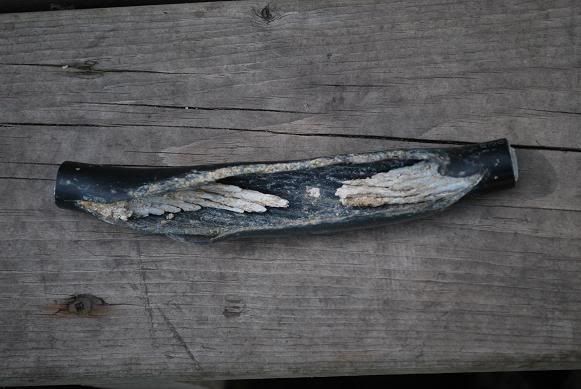I gat a call from a new customer last week who had a electrical problem with a outbuilding.
This building is fed from a Main Breaker panel located at his house house, approx. 75 feet away.
The building is fed with 4/0 al URD Quarduplex cable, direct buried.
240V single phase.
The cable was buried about 2 months ago.
The customer turned on the lights to his building and noticed that the lights were very dim.
Also, none of his 230V equipment would work.
I checked voltage at the Main....240V OK.
Checked voltage at the out building panel.... 200V.
120V one leg to ground, 80V other leg to ground.
I disconnected the cables at each end, and there was no continuity between any of the conductors.
I plugged one of my meter leads into the earth and checked each leg to to earth.
Three legs read infinity...good.
The other (one of the hots) read 1200 Ohms to earth....Uh oh.
I Told the owner that we had a damaged underground cable.
The owner has a backhoe, deep pockets and plenty of time, so he starts digging the cable up.
What we found really suprised me.
At one location the cable insulation was split about 3 inches, and the aluminum was completely corroded into aluminum oxide, or what ever it turns into when it turns to powder.
It was buried in damp, red clay, and there was nothing special about the dirt that I'm aware of.
The "installer", whom I replaced, must have damaged the insulation during burial.:roll:
I'm suprised that the aluminum failed so fast, plus, the owner had been using the shop the day before, and didn't notice any problem.
It finally failed when the last strand opened.
It had only been conducting electricity about 3 weeks, and that was part time at best.
I replaced the cable (in PVC conduit this time) and covered it up...problem solved.
I'm still wondering how that aluminum failed so fast.
steve
This building is fed from a Main Breaker panel located at his house house, approx. 75 feet away.
The building is fed with 4/0 al URD Quarduplex cable, direct buried.
240V single phase.
The cable was buried about 2 months ago.
The customer turned on the lights to his building and noticed that the lights were very dim.
Also, none of his 230V equipment would work.
I checked voltage at the Main....240V OK.
Checked voltage at the out building panel.... 200V.
120V one leg to ground, 80V other leg to ground.
I disconnected the cables at each end, and there was no continuity between any of the conductors.
I plugged one of my meter leads into the earth and checked each leg to to earth.
Three legs read infinity...good.
The other (one of the hots) read 1200 Ohms to earth....Uh oh.
I Told the owner that we had a damaged underground cable.
The owner has a backhoe, deep pockets and plenty of time, so he starts digging the cable up.
What we found really suprised me.
At one location the cable insulation was split about 3 inches, and the aluminum was completely corroded into aluminum oxide, or what ever it turns into when it turns to powder.
It was buried in damp, red clay, and there was nothing special about the dirt that I'm aware of.
The "installer", whom I replaced, must have damaged the insulation during burial.:roll:
I'm suprised that the aluminum failed so fast, plus, the owner had been using the shop the day before, and didn't notice any problem.
It finally failed when the last strand opened.
It had only been conducting electricity about 3 weeks, and that was part time at best.
I replaced the cable (in PVC conduit this time) and covered it up...problem solved.
I'm still wondering how that aluminum failed so fast.
steve



